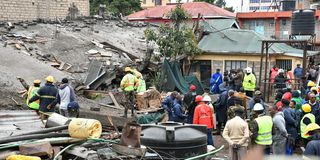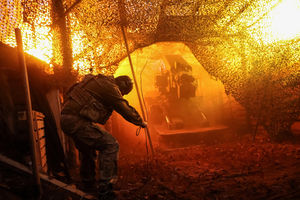Premium
Tumbling houses' deaths rise amid slow wheels of justice

Personnel from the Disaster Response Unit search for survivors in the Ruaka building collapse on November 17, 2022.
At least five owners and 10 government officials have been on trial for the deaths of over 100 people in collapsed buildings but the cases are still dragging in court more than five years later.
With no one being punished by the authorities and the delayed trials in court, the number of Kenyans dying from tumbling houses continues to rise. Other survivors are left nursing life-threatening injuries.
The 2011 decision of the government to establish the National Construction Authority (NCA) to control the construction sector has not helped much as multi-storey buildings have continued to come down, mostly during the rainy season.
Among the pending court trials is that of the owner of Precious Talent Academy in Dagoretti Nairobi, Mr Moses Ndirangu.
He was charged with manslaughter for causing the deaths of eight pupils on September 23, 2019, after a two-storey building collapsed. He was charged in February 2020. The trial is ongoing in Kibera chief magistrate’s court.
He was charged alongside eight top officials of the Nairobi County government.
Manslaughter
Another ongoing case is that of the two owners of a five-storey building that collapsed at Casanova in Huruma, Nairobi, on June 2, 2018.
Mr James Maigwa and Teresia Mwangi faced charges of manslaughter following the death of three people in the tumbled building.
In fighting the charges, Ms Mwangi stated that due to the prolonged rains, the foundation of the building was affected and she informed the Nairobi County officials who informed the tenants to vacate the premises.
However, a few tenants refused to vacate the premises and on the night of June 2, 2018, the building collapsed due to the rains.
In another case, Mr Samuel Karanja, the owner of a house that also collapsed in Nairobi’s Huruma estate, was charged with 52 counts of manslaughter in April 2016. The 52 people died when a six-storey building came down in heavy rain.
Though the building had been declared unfit to live in, over 100 rooms had been rented out and occupied.
Mr Karanja faced other counts related to the construction of the building. He was accused of carrying out development within the area of local authority without development permission, unlawful occupation of public land and giving false information to a person employed in the public service.
The investor was charged alongside five others including an employee of the National Construction Authority responsible for the area where the ill-fated residential complex was located, the Nairobi County director of planning compliance in charge of the area and the Mathare Sub-County administrator.
The court heard that they committed the offence jointly with others not before the court on April 29, 2016, at Ngei II Estate in Starehe Sub County, Nairobi County.
Poor workmanship
The collapse of the said building was attributed to poor workmanship, the shallow foundation on black cotton soil, structural defects due to poor concrete mix, use of sub-standard bars, lack of adequate reinforcements and lack of building supervision.
Another trial is that of Mr Isaac Njoro, owner of the building that collapsed in Roysambu, Kasarani, in April 2015 killing six people. The engineer of the building, Julius Karachi, was discharged from the court trial on April 26, 2019, and turned to a prosecution witness.
Mr Njoro had contested the court’s decision on grounds that the engineer bore a greater proportion of responsibility having sanctioned the construction of the ill-fated building in his capacity as the contracted engineer.
In Kisii County, the owner of a building that collapsed at Daraja in November 2016, killing nine people who were working at the site, is still fighting the manslaughter charges.
Forty people were also injured when the 10-storey building owned by businessman Jeremiah Matoke collapsed.
In other instances, owners of the fallen buildings have gone scot-free. For instance, the owner of a five-storey building under construction in Kiambu town in October 2009, claiming 13 lives, was freed by the court. No one was held accountable.
The owner, Mr Stephen Kimani, together with the engineer of the then Kiambu municipal council, the designer and the contractor were charged in a Kiambu court with causing the deaths.
Acquitted
They were, however, acquitted three years later on grounds that the prosecution had failed to prove the case beyond reasonable doubt.
On December 17, 2021, a four-storey building in Gatanga, Murang’a County, collapsed and killed six people.
It took the efforts of the Kenya Defence Forces, National Youth Service, police and Kenya Red Cross to rescue the 43 people who were trapped under the debris, a task that took days to complete.
While visiting the Murang’a site, Transport and Housing CS James Macharia revealed that the National Building Inspectorate (NBI) had recently completed an audit of several structures across the country.
The audit revealed that there were at least 4,000 buildings that were under imminent threat of collapse, and could risk killing or seriously injuring thousands of Kenyans.
Mr Macharia ordered that demolition of the 4,000 buildings, some still under construction, commence immediately.
Nearly a year later, Mr Macharia left office after President William Ruto replaced him with former Elgeyo-Marakwet Senator Kipchumba Murkomen.
Housing and Urban Development have been moved to the Ministry of Lands, under Zacharia Mwangi Njeru.
No demolition
But no demolition of condemned buildings has taken place as Kenyans continue to lose lives when unsafe structures collapse.
County government officials, the National Construction Authority and other government bureaucrats tasked with regulating the industry look on as dangerous structures come up, and their owners cut corners at the expense of innocent lives.
Five people have died in 24 hours in separate building collapses in Kasarani and Ruaka, Nairobi County.
Authorities are now interested in talking to Joel Kamau Kibe, a billionaire not new to controversy, who owns the seven-storey building in Kasarani that killed three people on Tuesday night.
Ownership of the six-storey building in Ruaka is yet to be made public.
At the time the NBI concluded its countrywide audit last year, no action was yet to be taken on another 2018 probe that found only 2,194 safe buildings in Nairobi.
Most of the 14,895 buildings inspected in the capital city were found to be unsafe.
Of the condemned buildings, 723 were an imminent danger, while 10,791 were unsafe for various reasons, including ventilation. In total, 10,791 buildings were declared unsafe and another 1,217 were found to be in fair condition. Huruma led the pack with 388 buildings under imminent threat of collapse.
At least 200 people have died in buildings collapses in the past six years, with no sign of justice visiting rogue developers and greedy landlords who look to cut costs.
Lands, Housing and Urban Development CS Zachary Njeru did not respond to our queries on whether the NBI will be ordered to proceed with demolishing unsafe buildings.






